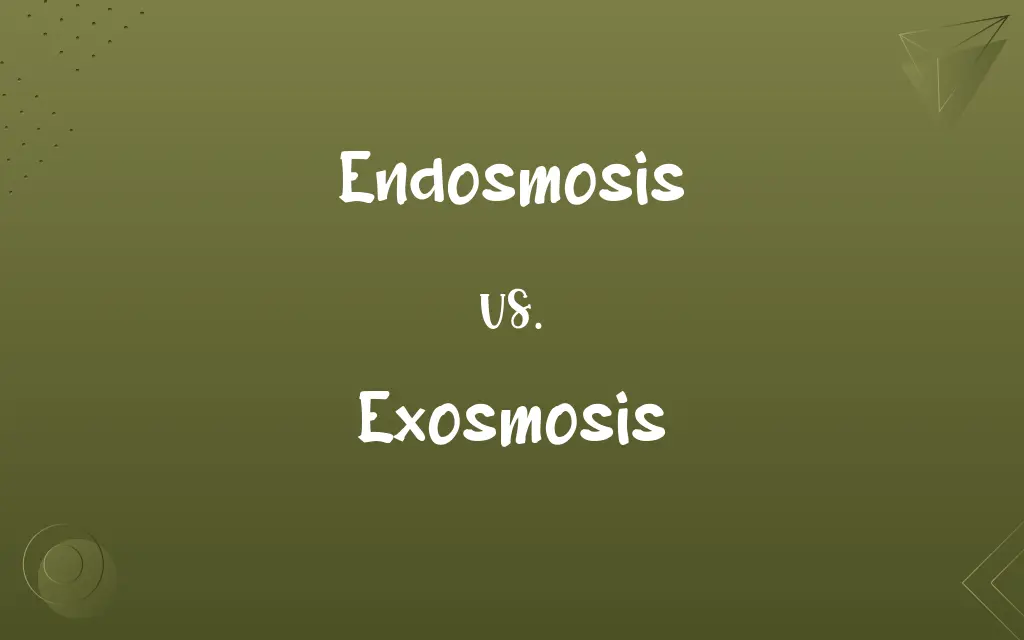Endosmosis vs. Exosmosis: Know the Difference

By Shumaila Saeed || Published on February 21, 2024
Endosmosis is the movement of a solvent (like water) into a cell or structure through a semipermeable membrane. Exosmosis is the opposite, where the solvent exits the cell or structure.

Key Differences
Endosmosis and Exosmosis are critical biological processes involving the movement of a solvent across a semipermeable membrane. Endosmosis occurs when a solvent, typically water, moves into a cell, causing it to swell. In contrast, Exosmosis is when the solvent exits the cell, leading to cell shrinkage. These processes are essential in maintaining cellular integrity and function.
Shumaila Saeed
Feb 21, 2024
In Endosmosis, the solvent moves from a region of lower solute concentration to a higher one inside the cell, balancing the solute concentrations on both sides of the membrane. Conversely, in Exosmosis, the movement is from a region of higher solute concentration inside the cell to a lower one outside, again striving for equilibrium. These movements are part of osmotic pressure regulation.
Shumaila Saeed
Feb 21, 2024
The role of the semipermeable membrane is crucial in both Endosmosis and Exosmosis. In Endosmosis, this membrane allows the solvent to enter but restricts certain solutes, causing a net inflow of water. In Exosmosis, the same selective permeability results in a net outflow of water, as the cell releases solvent to equalize solute concentration with its surroundings.
Shumaila Saeed
Feb 21, 2024
The implications of Endosmosis and Exosmosis extend to various biological phenomena. Endosmosis can cause cells in a hypotonic solution (lower solute concentration outside) to become turgid. On the other hand, Exosmosis can lead to cell plasmolysis in hypertonic solutions (higher solute concentration outside), where cells lose water and shrink.
Shumaila Saeed
Feb 21, 2024
Lastly, both Endosmosis and Exosmosis play a significant role in plant and animal physiology. Endosmosis helps in nutrient absorption and maintaining cell turgidity, vital for plant rigidity. Exosmosis is crucial in processes like urine formation in kidneys and maintaining osmotic balance in cells, ensuring proper cellular function.
Shumaila Saeed
Feb 21, 2024
ADVERTISEMENT
Comparison Chart
Direction of Flow
Movement of solvent into a cell or structure.
Movement of solvent out of a cell or structure.
Shumaila Saeed
Feb 21, 2024
Concentration Gradient
From lower to higher solute concentration (towards the cell).
From higher to lower solute concentration (away from the cell).
Shumaila Saeed
Feb 21, 2024
Cellular Impact
Can cause cells to swell and become turgid.
Can cause cells to shrink and may lead to plasmolysis.
Shumaila Saeed
Feb 21, 2024
Environmental Condition
Occurs in hypotonic solutions.
Occurs in hypertonic solutions.
Shumaila Saeed
Feb 21, 2024
Physiological Role
Important for nutrient absorption and maintaining cell turgidity.
Crucial in processes like urine formation and osmotic balance.
Shumaila Saeed
Feb 21, 2024
ADVERTISEMENT
Endosmosis and Exosmosis Definitions
Endosmosis
Endosmosis is the osmotic flow of water into a region of higher solute concentration.
Endosmosis is observed when a raisin placed in water plumps up.
Shumaila Saeed
Jan 18, 2024
Exosmosis
Exosmosis refers to the efflux of water from a cell or vesicle.
Exosmosis caused the plant cell to shrink in a saline solution.
Shumaila Saeed
Jan 18, 2024
Endosmosis
Endosmosis is the inward diffusion of a solvent through a semipermeable membrane.
In endosmosis, plant roots absorb water from the soil.
Shumaila Saeed
Jan 18, 2024
Exosmosis
Exosmosis is the outward movement of a solvent through a semipermeable membrane.
In exosmosis, water leaves the cell when it is placed in a salt solution.
Shumaila Saeed
Jan 18, 2024
Endosmosis
Endosmosis is the process of solvent migration into a cell in a hypotonic environment.
Endosmosis occurs in red blood cells when submerged in pure water.
Shumaila Saeed
Jan 18, 2024
ADVERTISEMENT
Exosmosis
Exosmosis is the release of fluid from a cell through its membrane.
The exosmosis process caused dehydration in the cells.
Shumaila Saeed
Jan 18, 2024
Endosmosis
Endosmosis is the absorption of fluid by a cell through its membrane.
The endosmosis process helped hydrate the dehydrated cells.
Shumaila Saeed
Jan 18, 2024
Exosmosis
Exosmosis is the process of solvent migration out of a cell in a hypertonic environment.
Exosmosis occurs in red blood cells in a concentrated saline solution.
Shumaila Saeed
Jan 18, 2024
Endosmosis
Endosmosis refers to the movement of water into a cell or vesicle.
Endosmosis caused the onion cells to swell when placed in distilled water.
Shumaila Saeed
Jan 18, 2024
Exosmosis
Exosmosis is the osmotic flow of water out of a region of higher solute concentration.
Exosmosis is observed in a salted cucumber, which loses water.
Shumaila Saeed
Jan 18, 2024
Endosmosis
The inward flow of a fluid through a permeable membrane toward a fluid of greater concentration.
Shumaila Saeed
Jan 17, 2024
Exosmosis
The passage of a fluid through a semipermeable membrane toward a solution of lower concentration, especially the passage of water through a cell membrane into the surrounding medium.
Shumaila Saeed
Jan 17, 2024
Endosmosis
Osmosis in which fluid flows through a membrane towards a region of higher concentration
Shumaila Saeed
Jan 17, 2024
Exosmosis
Osmosis in which fluid flows through a membrane towards a region of lower concentration
Shumaila Saeed
Jan 17, 2024
Repeatedly Asked Queries
How does Endosmosis differ from Exosmosis in terms of direction?
Endosmosis involves solvent movement into a cell, while Exosmosis involves solvent moving out of a cell.
Shumaila Saeed
Feb 21, 2024
What role does the concentration gradient play in Endosmosis and Exosmosis?
In Endosmosis, solvent moves from a lower to a higher solute concentration, and in Exosmosis, it moves from higher to lower concentration.
Shumaila Saeed
Feb 21, 2024
What is Endosmosis?
Endosmosis is the movement of a solvent, usually water, into a cell across a semipermeable membrane.
Shumaila Saeed
Feb 21, 2024
Why are Endosmosis and Exosmosis important in biology?
They are crucial for maintaining cellular integrity, osmotic balance, and proper physiological functions in organisms.
Shumaila Saeed
Feb 21, 2024
In what type of solution does Endosmosis predominantly occur?
Endosmosis predominantly occurs in hypotonic solutions.
Shumaila Saeed
Feb 21, 2024
Can Endosmosis and Exosmosis affect plant cells?
Yes, these processes significantly impact plant cells, influencing turgidity and plasmolysis.
Shumaila Saeed
Feb 21, 2024
Are Endosmosis and Exosmosis passive or active processes?
Both are passive processes driven by the osmotic gradient across the semipermeable membrane.
Shumaila Saeed
Feb 21, 2024
What happens to a cell during Endosmosis?
During Endosmosis, a cell may swell due to the influx of solvent.
Shumaila Saeed
Feb 21, 2024
In what type of solution does Exosmosis primarily take place?
Exosmosis primarily occurs in hypertonic solutions.
Shumaila Saeed
Feb 21, 2024
What is Exosmosis?
Exosmosis is the movement of a solvent, typically water, out of a cell through a semipermeable membrane.
Shumaila Saeed
Feb 21, 2024
Can Endosmosis and Exosmosis occur simultaneously in the same cell?
Yes, they can occur simultaneously in different parts of the same cell, maintaining osmotic balance.
Shumaila Saeed
Feb 21, 2024
What is the role of Endosmosis in nutrient absorption?
Endosmosis facilitates the absorption of nutrients and water into cells, essential for cellular function.
Shumaila Saeed
Feb 21, 2024
How does Exosmosis contribute to urine formation?
Exosmosis plays a role in removing excess water and solutes from the body, crucial in urine formation.
Shumaila Saeed
Feb 21, 2024
What happens to a cell during Exosmosis?
During Exosmosis, a cell may shrink or undergo plasmolysis due to the efflux of solvent.
Shumaila Saeed
Feb 21, 2024
How do Endosmosis and Exosmosis affect animal cells?
In animal cells, these processes can lead to cell swelling or shrinking, affecting cell function.
Shumaila Saeed
Feb 21, 2024
What is an example of Endosmosis in daily life?
Absorption of water by raisins soaked in water is a common example of Endosmosis.
Shumaila Saeed
Feb 21, 2024
Can environmental conditions affect Endosmosis and Exosmosis?
Yes, environmental solute concentrations greatly influence both Endosmosis and Exosmosis in cells.
Shumaila Saeed
Feb 21, 2024
What can excessive Endosmosis lead to in cells?
Excessive Endosmosis can lead to cell bursting or lysis, especially in animal cells without cell walls.
Shumaila Saeed
Feb 21, 2024
Is osmotic pressure involved in Endosmosis and Exosmosis?
Osmotic pressure is a key driving force behind both Endosmosis and Exosmosis.
Shumaila Saeed
Feb 21, 2024
What is a semipermeable membrane in the context of Endosmosis and Exosmosis?
It's a membrane that allows certain molecules or ions to pass through by diffusion and occasionally specialized "facilitated diffusion."
Shumaila Saeed
Feb 21, 2024
Share this page
Link for your blog / website
HTML
Link to share via messenger
About Author
Written by
Shumaila SaeedShumaila Saeed, an expert content creator with 6 years of experience, specializes in distilling complex topics into easily digestible comparisons, shining a light on the nuances that both inform and educate readers with clarity and accuracy.


































































